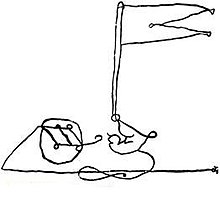Solomon Molcho
Solomon Molcho | |
|---|---|
 Stylized signature of Solomon Molcho. Source: Manuscript owned by the Alliance Israélite Universelle | |
| Born | Diogo Pires 1500 |
| Died | 13 December 1532 (aged 32) |
| Cause of death | Executed (burning at stake) |
Solomon Molcho (
burned at the stake
.
Early life
Nothing is known of Molcho's family or even the exact date of his birth. He was born in Portugal sometime between September 1500 and August 1502, probably to
circumcised himself, though without thereby gaining Reubeni's favor, and was forced to emigrate.[3]
Mystic studies
Molcho became a master Talmudist and biblical exegesist, and then studied the
cardinals at Rome. He warned the Pope to leave Rome as the city would soon be flooded and he sent a message to the king of Portugal warning of an imminent earthquake. The occurrence of a deadly flood on 8 October 1530, and an earthquake in Lisbon on 26 January 1531,[6]
raised Molcho's reputation among the religious and political authorities.
Travels and execution
In company with
Ratisbon, where the emperor Charles V was holding a diet. On this occasion, Molcho carried a flag with the Hebrew word Maccabi, the four letters מכבי which also signify an abbreviation for Exodus 15:11 "Who among the mighty is like unto God?".[7] The three met for two hours, and while the exact content of the meeting was not recorded, letters written from the court at the time indicate Molcho proposed the establishment of a joint Jewish-Christian army[8] to fend off the emperor's foreign enemies and, possibly, to reconquer the Holy Land. The emperor had both Molcho and Reubeni arrested and took them back to Italy. In Mantua an ecclesiastical court sentenced Molcho to death by fire. Molcho was taken to the stake in November or December 1532 (a Jewish tradition lists the date as 5th of Tevet 5293 but there are no records to confirm the date). It is claimed the emperor offered to pardon him on condition that he return to the Catholic Church, but Molcho refused, asking for a martyr's death.[9]
His mentor, David Reubeni, was exiled to Spain, where later he died.
Writings
Molcho published a book of homilies Derashot on the Bible entitled Sefer Hamefoar, based mostly on the Talmud and Midrash, in
bowdlerized and censored form, in Amsterdam
in 1660, in a book entitled Hayat Kaneh. Modern scholars have discovered several more works by Molcho, including a second book, which he had prepared for publication at the time of his death and which focused on Messianic redemption and emphasized the Kabbala, and a song, and the transcript of a synagogue lecture Molcho delivered in the spring of 1531. His second book, along with his homilies and other writings, including uncensored versions of his letters, were published as Kitvei Shlomo Molcho (The Collected Writings of Shlomo Molcho) in Jerusalem in 2019.
Molcho's writings and speeches highlighted the roles of the
Messiah ben David in the process of redemption and stressed that redemption could come if Jews were faithful to God and his commandments or if the non-Jewish religious and political powers were exceedingly evil and oppressive. A dream Molcho had in 1526 apparently led him to believe he was destined to be either the Messiah ben Joseph or his precursor, but in none of his writings or speeches did he ever explicitly state this or proclaim himself the Messiah.[10]
See also
- List of people burned as heretics
- Jewish Messiah claimants
References
- Targum Press, Southfield, MI, 2004, p216.
- ISBN 978-965-91936-3-9, p. 125 (Hebrew)
- ISBN 978-965-91936-2-2, p. 7 (Hebrew)
- ^ Lechu Neranena Le'et Hageula, pp. 5, 37.
- ^ Gedaliah ibn Yahya ben Joseph, Shalshelet Ha-Kabbalah Jerusalem 1962, p. 112 in PDF (Hebrew)
- ^ Kitvei Shlomo Molcho, The Collected Writings of Shlomo Molcho, p. 109.
- ^ Singer, Isidore; Bloch, Phillipp. "Molko, Solomon" in Jewish Encyclopedia. Funk and Wagnalls, New York. 1901-1906.
- ^ J Kracuaer, Rabbi Joselmann de Rosheim, REJ, XVI, 91.
- ^ Gedaliah ibn Yahya ben Joseph, Shalshelet Ha-Kabbalah Jerusalem 1962, p. 112 in PDF (Hebrew)
- ^ Lechu Neranena Le'et Hageula, p. 11.
- Encyclopædia Britannica
- This article incorporates text from a publication now in the public domain: Chisholm, Hugh, ed. (1911). "Molko". Encyclopædia Britannica (11th ed.). Cambridge University Press.
 This article incorporates text from a publication now in the public domain: Singer, Isidore; et al., eds. (1901–1906). "Molko, Solomon". The Jewish Encyclopedia. New York: Funk & Wagnalls.
This article incorporates text from a publication now in the public domain: Singer, Isidore; et al., eds. (1901–1906). "Molko, Solomon". The Jewish Encyclopedia. New York: Funk & Wagnalls.
External links
Wikimedia Commons has media related to Solomon Molcho.
- The Jewish Museum of Prague preserves a robe and a flag of Molcho.
- The Kabbalist Who Wanted a Jewish Army in 1532
